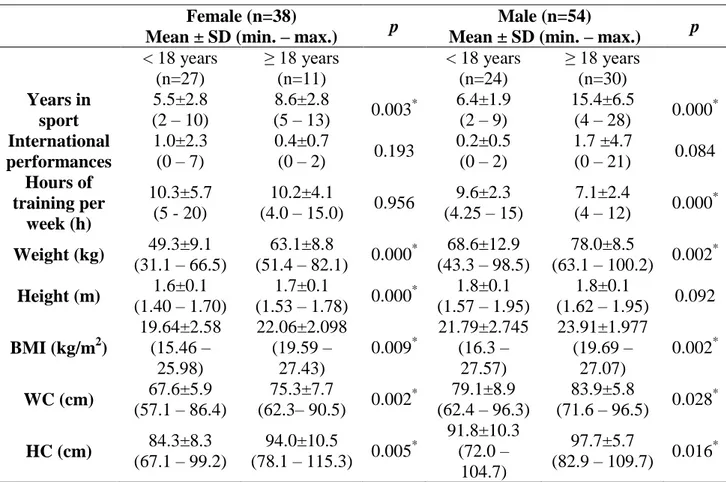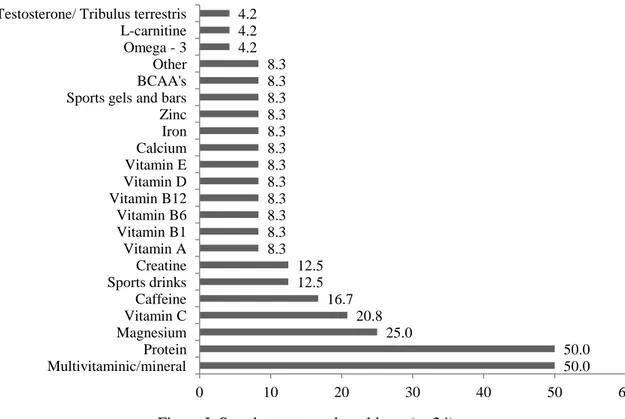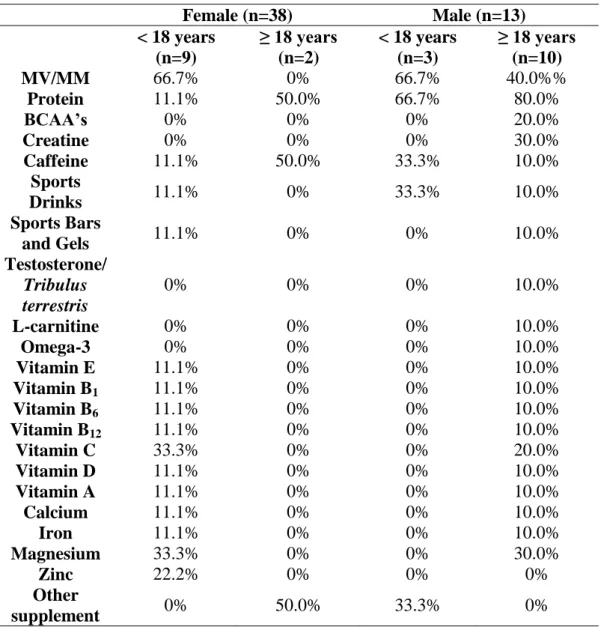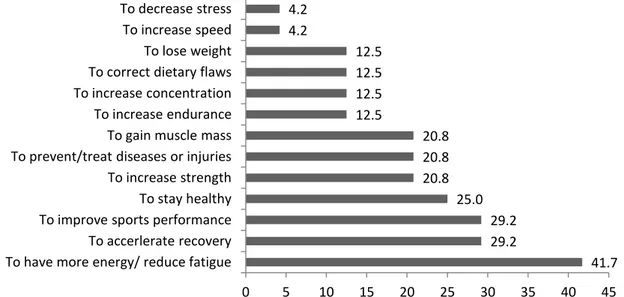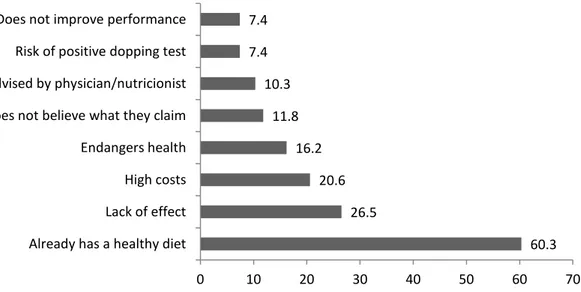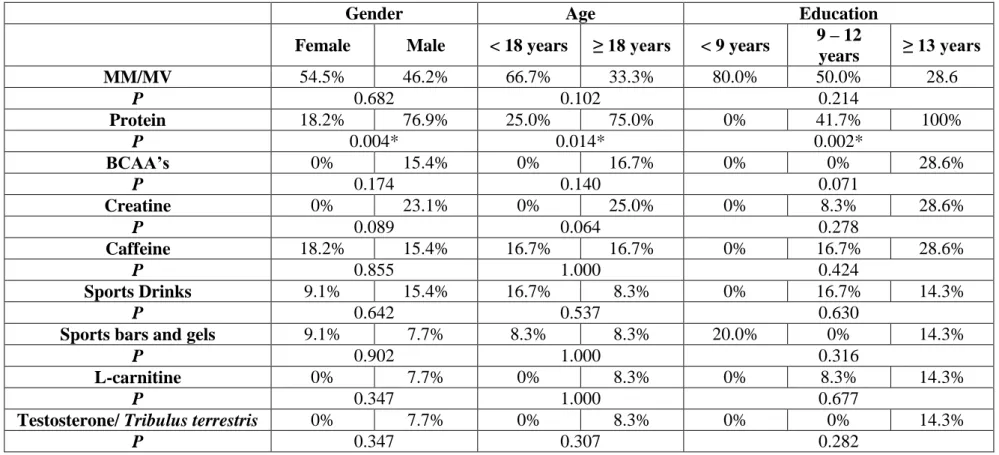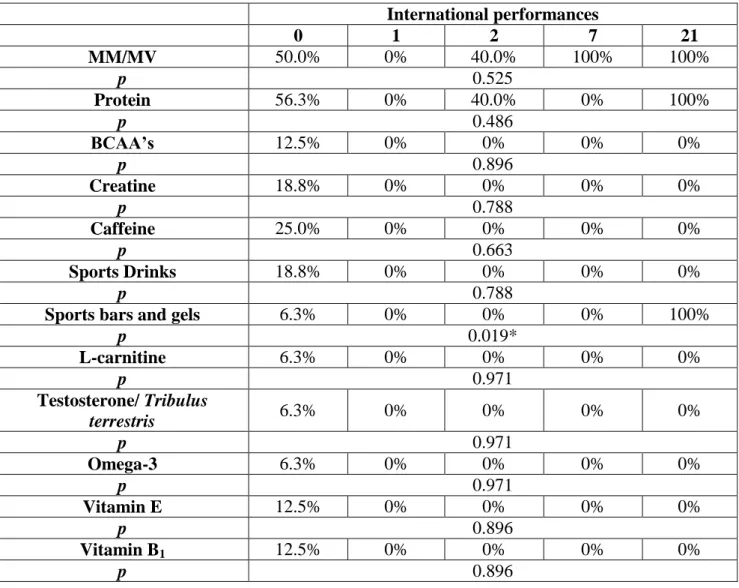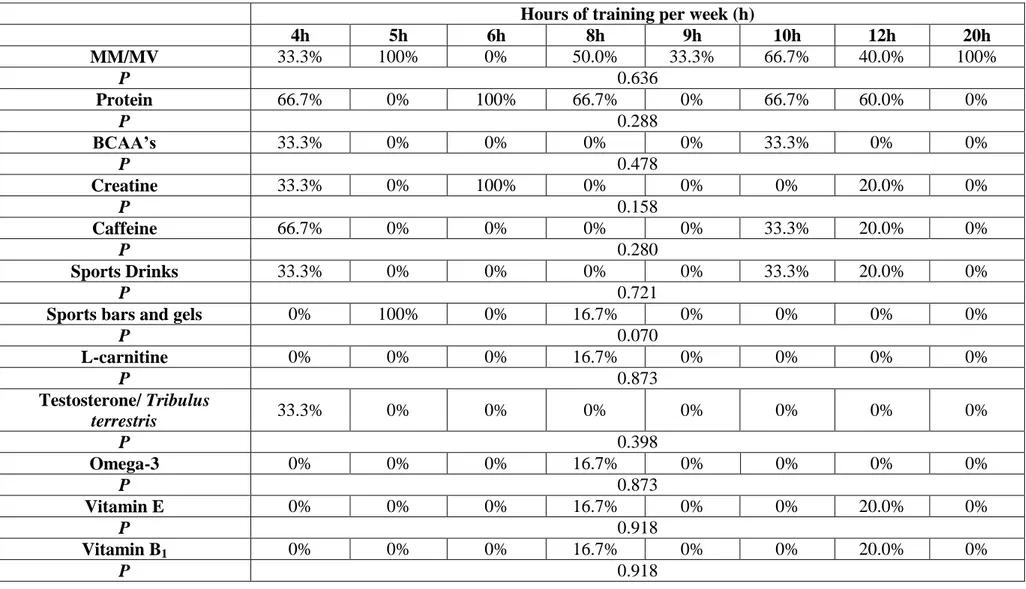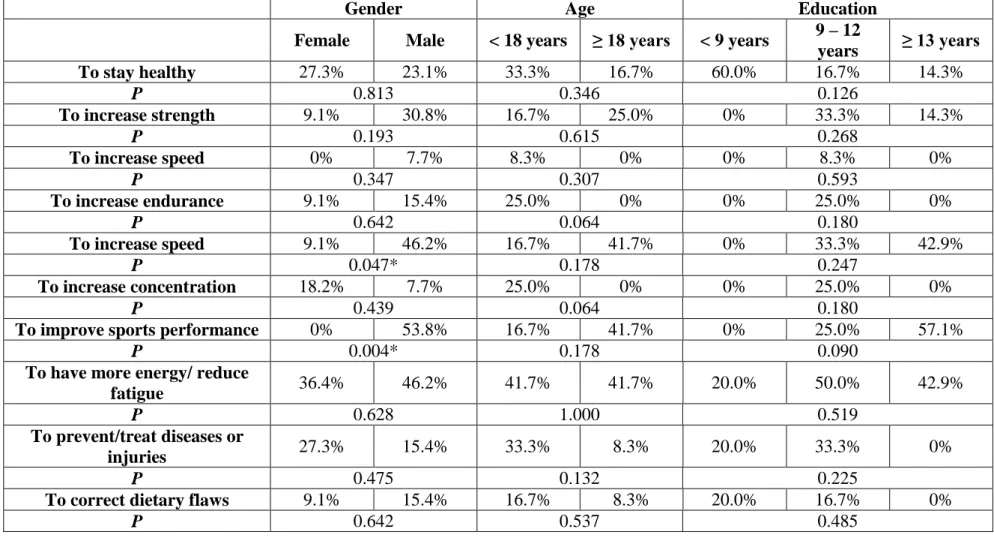Carla Antónia Teixeira Dias
Nutritional supplements: knowledge and behaviors of Portuguese athletes
Universidade Fernando Pessoa Faculdade Ciências da Saúde
Carla Antónia Teixeira Dias
Nutritional supplements: knowledge and behaviors of Portuguese athletes
Universidade Fernando Pessoa Faculdade Ciências da Saúde
Carla Antónia Teixeira Dias
Nutritional supplements: knowledge and behaviors of Portuguese athletes
________________________________ (Carla Antónia Teixeira Dias)
Orientadora: Prof.ª Doutora Raquel Silva Trabalho Complementar apresentado à Universidade Fernando
Pessoa como parte dos requisitos para obtenção do grau de licenciado em Ciências da Nutrição
Nutritional supplements: knowledge and behaviors of Portuguese athletes Carla Antónia Teixeira Dias1, Maria-Raquel G. Silva1
1
Faculty of Health Sciences, University Fernando Pessoa, Oporto, Portugal
Corresponding author Carla Antónia Teixeira Dias
Faculty of Health and Sciences, University Fernando Pessoa Rua Carlos da Maia, 296 | 4200-150 Porto, Portugal
E-mail: 27591@ufp.edu.pt
Short title: Knowledge and behaviors of Portuguese athletes, Nutritional supplements Word count: 7254
Number of tables: 15
Abstract
Introduction: Supplementation is a practice that has gained popularity among athletes, especially in elite individuals, related with increased physical demands. Several are the reasons for taking nutritional supplements, related to health or sports performance. Objective: To assess the prevalence of nutritional supplements in athletes, including: the type of supplements use, sources of information and main reasons for their usage. Methods: Ninety two athletes (n=92) (41.3% female and 58.7% male) of five different sports participated voluntarily. A thirty-one questionnaire was used characterizing the prevalence of supplement use, sources of information and the main reasons for consumption. Data were analyzed using the Statistical Package for Social Sciences (IBM SPSS Statistics) version 22 for Windows. Mean and standard deviation were used for continuous variables and proportions for categorical variables. T-tests and Chi-square were applied and the significant level used was 5% (p < 0.05).
Results: Only 24 athletes (26.1%) consumed nutritional supplements with a mean of 3 supplements per athletes. Multivitaminics/minerals and protein supplements were the most used (50.0%) and significant associations were found between protein usage and age, gender and education. The main reasons for taking supplements were related to sports performance and the principal source of information was the physician (45.8%) followed by him/herself (20.8%). Twelve significant associations were found between the most consumed supplements and the reasons for taking. The presence of a healthy diet (60.3%) was the main reason for not taking supplements.
Conclusion: Few athletes in this study used supplements, and the level of competition can be one of the factors for this result. Errors were found liking the reasons and the type of supplement, which can be related with the adviser. This error shows the necessity for education about this theme at all the engaging parts around the athletes’ life.
Keywords: nutritional supplements, athletes, adolescents, adults, behaviors. Resumo
Introdução: A toma de suplementos é uma prática que cada vez mais ganha popularidade entre os atletas, principalmente em atletas de elite, estando relacionado
Nutritional supplements: knowledge and behaviors of Portuguese athletes
1
com o aumento das exigências físicas. São várias as razões da toma de suplementos, quer a nível da saúde, quer a nível do desempenho desportivo e esta prática muitas vezes é guiada por fontes não credíveis.
Objetivo: avaliar a prevalência de suplementos em atletas incluindo o tipo de suplementos consumidos, as fontes de informação e as rasões para a sua toma.
Métodos: Noventa e dois atletas (41,3% do sexo feminino e 58,7% do sexo masculino) de cinco modalidades diferentes participaram voluntariamente. Foi utilizado um questionário com trinta e uma questões caracterizando a prevalência do uso de suplementos, as fontes de informação e as principais razões para o consumo. Os dados recolhidos foram analisados através do Statistical Package for Social Sciences (IBM SPSS Statistics) versão 22 para o Windows. Para as variáveis contínuas foi calculada a média e o desvio padrão e percentagens para as variáveis categóricas. Teste t-student foi aplicado nas variáveis contínuas e o de qui-quadrado para as categóricas e foi utilizado um nível de significância de 5%.
Resultados: Apenas 24 atletas (26,1%) consumiam suplementos, com uma média de três suplementos por atleta. Os suplementos mais consumidos foram os multivitamínicos/minerais e os suplementos de proteína (50%) e foram encontradas associações significativas entre o consumo de proteína e a idade, sexo e escolaridade. As razões mais citadas estavam relacionadas com o desempenho desportivo, e a principal fonte de informação foi o médico (45,8%) seguido pelo próprio (20.8%). Foram encontradas doze associações significativas entre os suplementos mais consumidos e as razões para o seu consumo. A presença de uma alimentação saudável (60,3%) foi o principal motivo para o não consumo de suplementos.
Conclusão: Foram poucos os atletas da amostra que tomavam suplementos, sendo o nível de competição um dos possíveis fatores para esta prevalência. Foram encontrados erros de concordância entre o consumo de suplementos e a razão para a sua toma, podendo estar relacionado com a sua fonte de informação. Estes erros demonstram a necessidade de educação acerca este tema a todas as partes envolventes na vida desportiva do atleta.
Palavras-chave: suplementos nutricionais; atletas; adolescentes, adultos, comportamentos.
2
Introduction
Research in sports nutrition has been increasing exponentially in recent years since it was shown that nutrition significantly influences the athletic performance in physical and mental domains. Energy and nutritional needs are specific for each athlete and are dependent on the type of sport (endurance, strength, velocity, aesthetic)1.
Supplementation is often practiced by athletes to gain some extra advantage in sport and over their opponents, when nutrition and training are not enough. Its use is more prevalent than in general population, and is gaining popularity in various sports1-9. The international prevalence of supplements usage varies between 37% and 89%10, more frequently in older and elite athletes2,3,5,7,10,11, being associated with increased physical demands at the highest level of physical training and also to continue to improve athletic performance12.
There are different definitions of the concept “supplement” and which supplements includes1,2,6,7,12. According to the Dietary Supplement Health and Education Act of 1994, the term “dietary supplement” includes any product orally consumed (except tobacco) to supplement someone’s diet that contains one or more dietary ingredients. These products may contain vitamins, minerals, herbs or botanicals, amino acids and substances like enzymes, organ tissues, glandular and metabolites, extracts or concentrates under the form of tablets, capsules, liquids, powders, bars, soft gels or caps gels2,3,7,12-14. Therefore, there is a range of supplements available with different and specific objectives1. However, the list of supplements with scientific evidence supporting its efficacy and safety is short1,2,4,10,11, and, unlike medication, these products do not undergo rigorous control criteria or require prior approval of regulatory authorities, which could be an alarming situation for athletes1,6,9,10. About 25% of supplements are contaminated with substances prohibited by World Anti-Doping Agency (WADA, 2016) and the main contaminant are anabolic steroids2,7. This presents a potential risk to the athlete’s health and a negative impact in the athlete’s career since he may be suspended for accusing positive in an anti-doping control test1,2,4,6,10,11. Additionally, as a result of excessive use of different supplements in high doses and for long periods of time or its inappropriate use, there exists the probability of toxicity, negative interactions between substances and health problems to neurological, hematological and cardiovascular levels1,3,4, 7-9,11,12,14.
Nutritional supplements: knowledge and behaviors of Portuguese athletes
3
There are several reasons for the use of supplements cited by athletes from improving their performance in different aspects – increase energy, speed, strength, endurance, muscle mass among others – and facilitate recovery to maintain health and prevent nutritional deficiencies and injuries3-5, 7,10,15-17. Usually, their practices are guided by family members, friends, Media, teammates and coaches and not by health professionals3,5,10,15 and, as a result, athletes can use nutritional supplements incorrectly15 given that they do not seek credible sources.
The purpose of this study is to assess the prevalence of nutritional supplements in athletes, including: the type of supplements use, sources of information and main reasons for their usage.
Material and Methods Participants
Ninety-two (n=92) athletes representing five different sports (volleyball, roller hockey, swimming, synchronized swimming and rhythmic gymnastics) participated voluntarily by completing a questionnaire regarding the use of nutritional supplements. This procedure was performed in a convenience sample since the questionnaire was applied to athletes living in the North of Portugal, specifically in clubs around the city of Espinho.
It was given an explanation about the purpose of the study to the subjects and informed consent was given by all participants. Additionally, for those athletes who were under age (under 18 years old), it was requested a formal authorization from their legal guardians. The study was approved by the Ethics Committee of the University Fernando Pessoa.
Questionnaire
The survey used in this study was previously validated and applied to evaluate the use of nutritional supplements in Portuguese athletes by Sousa et al.2. The questionnaire involved thirty-one questions in order to characterize the prevalence of nutritional supplements intake, the advisors that athletes relied on for information and the main reasons for the consumption in twelve months prior to completing the questionnaire, in addition to assessed socio-demographic and training data.
4
The survey was administered in person by the study investigators and participants were free to ask any questions regarding the questionnaire to the researchers.
The questions were generally closed-ended options in order to facilitate their completion and assist athletes to remember the type of supplements consumed. However, in all topics were include an open-ended alternative that allowed participants answer other assumptions that were not present. In this case, it was used the broader definition of nutritional supplements, which includes all types: nutritional/dietary supplements, ergogenic aids and sports foods.
Regarding different supplements, it was provided an updated list of 36 supplements2,10, 18,19
that included: multivitamins/minerals, proteins, branched-chain amino acids (BCAA’s), conjugated linoleic acid (CLA), omega-3, hydroxymethylbutyrate (HMB), Echinacea, arginine, glutamine, glucosamine, others amino acids, nitrate, ginseng, creatine, caffeine, sports drinks, sports bars and gels, other carbohydrate supplements, β-alanine, antioxidants, zinc, testosterone/Tribulus terrestris, sodium bicarbonate, herbs or plants, vitamins E, B1, C, B6, B12, D and A, magnesium, calcium, iron and L-carnitine.
Regarding the source of information/advice, athletes found an 8-item list: physician, coach, family, nutritionist, friends, him/herself, other athletes and social media. Reasons for the use of nutritional supplements there were thirteen options: stay healthy, increase strength, speed or endurance, accelerate recovery, increase focus, improve sports performance, have more energy/ reduce fatigue, prevent/treat diseases or injuries, correct dietary flaws, gain muscle mass, decrease stress and lose weight. The participants who took supplements were further questioned whether they were sponsored by any brand or if they had any price reduction.
Volunteers who did not consume any type of supplement were asked about the reasons for not taking them from an 8-item list: endanger health, risk test positive in doping test, inadvisable by physician/nutritionist, achievement of a balanced diet, high costs, discrediting the allegations, don’t improve performance and finally the lack of effect. Anthropometric measures
All the measurements were evaluated after completing the questionnaire. Weight was measured by digital scale (Becken) to the nearest 0.1 kg wearing workout clothes. Due
Nutritional supplements: knowledge and behaviors of Portuguese athletes
5
to the lack of a stadiometer, height was reported by athletes. Body Mass index (BMI) was calculated as a ratio of weight to the squared height (kg/m2). Waist circumference was measured at the smallest circumference between the thorax and the hip with a flexible tape at the end of a normal expiration. Hip circumference was also measured with a flexible tape at the largest circumference on trochanters.
Statistical Analyses
Mean and standard deviation were used for continuous variables and proportions for categorical variables. To test differences in years in sport practice, international performance, hours of training per week, weight, height, body mass index (BMI), waist and hip circumference, t-tests were applied and the significant level used was 5% (p < 0.05).
Chi-square tests for categorical variables and Phi (φ) coefficients to analyzed and describe the association between the reasons for supplements use and the type of nutritional supplement use were also applied. Data were analyzed using the Statistical Package for Social Sciences (IBM SPSS Statistics) version 22 for Windows.
Results
Ninety-two (92) athletes answered this questionnaire (41.3% female and 58.7% male) with a mean age of 18.3±5.9 years (range 10–38). As previously mentioned, these athletes belong to five different sports: swimming (28.3%), synchronized swimming (10.9%), roller hockey (20.7%), rhythmic gymnastics (6.5%) and volleyball (33.7%). Table I shows characteristics of the sample.
In both female and athletes, sport practice, weight, height, BMI, waist (WC) and hip (HC) circumferences were significantly higher in adults (≥ 18 years) than in adolescents with exception for the number of hours of training per week in young male athletes (9.61±2.348 vs. 7.12±2.43, p = 0.000 – Table I).
6
Female (n=38)
Mean ± SD (min. – max.) p
Male (n=54)
Mean ± SD (min. – max.) p < 18 years (n=27) ≥ 18 years (n=11) < 18 years (n=24) ≥ 18 years (n=30) Years in sport 5.5±2.8 (2 – 10) 8.6±2.8 (5 – 13) 0.003 * 6.4±1.9 (2 – 9) 15.4±6.5 (4 – 28) 0.000 * International performances 1.0±2.3 (0 – 7) 0.4±0.7 (0 – 2) 0.193 0.2±0.5 (0 – 2) 1.7 ±4.7 (0 – 21) 0.084 Hours of training per week (h) 10.3±5.7 (5 - 20) 10.2±4.1 (4.0 – 15.0) 0.956 9.6±2.3 (4.25 – 15) 7.1±2.4 (4 – 12) 0.000 * Weight (kg) 49.3±9.1 (31.1 – 66.5) 63.1±8.8 (51.4 – 82.1) 0.000 * 68.6±12.9 (43.3 – 98.5) 78.0±8.5 (63.1 – 100.2) 0.002 * Height (m) 1.6±0.1 (1.40 – 1.70) 1.7±0.1 (1.53 – 1.78) 0.000 * 1.8±0.1 (1.57 – 1.95) 1.8±0.1 (1.62 – 1.95) 0.092 BMI (kg/m2) 19.64±2.58 (15.46 – 25.98) 22.06±2.098 (19.59 – 27.43) 0.009* 21.79±2.745 (16.3 – 27.57) 23.91±1.977 (19.69 – 27.07) 0.002* WC (cm) 67.6±5.9 (57.1 – 86.4) 75.3±7.7 (62.3– 90.5) 0.002 * 79.1±8.9 (62.4 – 96.3) 83.9±5.8 (71.6 – 96.5) 0.028 * HC (cm) 84.3±8.3 (67.1 – 99.2) 94.0±10.5 (78.1 – 115.3) 0.005 * 91.8±10.3 (72.0 – 104.7) 97.7±5.7 (82.9 – 109.7) 0.016 *
Note: BMI: body mass index; WC: waist circumference; HC: hip circumference;
*
Performance differences determined by independent-samples t tests, p < 0.05.
Nutritional Supplements
Only 24 athletes (26.1%) were taking supplements during the twelve months prior completing questionnaire, being that eleven were female (45.8%) and thirteen were male (54.2%). They were reported a total of 72 supplements for 24 athletes, with a mean consumption of three supplements per athlete (range 1 – 5).
Overall, the most commonly supplements used were multivitamins/multiminerals (MM/MV) (50%) and protein supplements (50%), followed by magnesium (25%), vitamin C (20.8%) and caffeine (16.7% – Figure I). Figure I demonstrates the consumed supplements, of which creatine and sports drinks present the same proportion (12.5%). Other supplements were consumed exhibiting the same frequency (8.3%): vitamins A, B1, B6, B12, D and E, calcium, iron, zinc sports gels and bars and BCAA’s, ingested by only two athletes. Finally, L-carnitine, omega – 3 and testosterone/Tribulus terrestris were taken by one participant each (4.2%). Table II described the prevalence of type of supplement according to age and gender.
Nutritional supplements: knowledge and behaviors of Portuguese athletes
7
Multivitamin/minerals supplements (MV/MM) were the most commonly used by female adolescents (66.7%). Protein and MV/MM were the most used in male adolescents athletes (66.7%). 80% of adult male participants consumed protein supplements and 50% of female adults consumed either protein, caffeine or other supplements.
It was only found an association between the consumption of protein and athletes’ age, gender and education: its consumption was higher in male (76.9% vs. 18.2%, p = 0.004) and adult athletes (75% vs. 25%, p =0.014). All athletes with more than 13 years of education (n = 7; 100%) were taking protein supplements, being significantly higher (p = 0.002) than athletes with 9 to 12 years of education (n=12; 41.7%) or less than 9 years (n =5; 0%) of school attendance (Appendix I).
No association was found between nutritional supplements intake and athletic international performance and hours of training (p > 0.05) (Appendix I).
50.0 50.0 25.0 20.8 16.7 12.5 12.5 8.3 8.3 8.3 8.3 8.3 8.3 8.3 8.3 8.3 8.3 8.3 8.3 4.2 4.2 4.2 0 10 20 30 40 50 60 Multivitaminic/mineral Protein Magnesium Vitamin C Caffeine Sports drinks Creatine Vitamin A Vitamin B1 Vitamin B6 Vitamin B12 Vitamin D Vitamin E Calcium Iron Zinc Sports gels and bars BCAA's Other Omega - 3 L-carnitine Testosterone/ Tribulus terrestris
8 Female (n=38) Male (n=13) < 18 years (n=9) ≥ 18 years (n=2) < 18 years (n=3) ≥ 18 years (n=10) MV/MM 66.7% 0% 66.7% 40.0%% Protein 11.1% 50.0% 66.7% 80.0% BCAA’s 0% 0% 0% 20.0% Creatine 0% 0% 0% 30.0% Caffeine 11.1% 50.0% 33.3% 10.0% Sports Drinks 11.1% 0% 33.3% 10.0% Sports Bars and Gels 11.1% 0% 0% 10.0% Testosterone/ Tribulus terrestris 0% 0% 0% 10.0% L-carnitine 0% 0% 0% 10.0% Omega-3 0% 0% 0% 10.0% Vitamin E 11.1% 0% 0% 10.0% Vitamin B1 11.1% 0% 0% 10.0% Vitamin B6 11.1% 0% 0% 10.0% Vitamin B12 11.1% 0% 0% 10.0% Vitamin C 33.3% 0% 0% 20.0% Vitamin D 11.1% 0% 0% 10.0% Vitamin A 11.1% 0% 0% 10.0% Calcium 11.1% 0% 0% 10.0% Iron 11.1% 0% 0% 10.0% Magnesium 33.3% 0% 0% 30.0% Zinc 22.2% 0% 0% 0% Other supplement 0% 50.0% 33.3% 0% Note: MV/MM: multivitamincs/multiminerals Reasons for Usage
The three most cited reasons for supplements usage (Figure II) were: “to have more energy/ reduce fatigue” (41.7%), “to accelerate recovery” (29.2%) and “to improve sports performance” (29.2%). Table III demonstrate the reasons cited according to age and gender.
Nutritional supplements: knowledge and behaviors of Portuguese athletes
9
“To stay healthy”, “to have more energy/reduce fatigue” and “to prevent/treat diseases or injuries” were the most cited reasons by young female athletes (33.3%). Female adults only chose “to accelerate recovery”, “to have more energy/reduce fatigue” and “to lose weight” as motives for taking supplements (50.0%). When it comes to male athletes, participants under 18 years old use supplements “to increase endurance”, “to accelerate recovery”, “to improve sports performance” and “to have more energy/decrease fatigue” (66.7%). “To improve sports performance” and to gain muscle mass” were the principal reasons for adult athletes.
Female (n=38) Male (n=13) < 18 years (n=9) ≥ 18 years (n=2) < 18 years (n=3) ≥ 18 years (n=10) To stay healthy 33.3% 0% 33.3% 20.0% To increase strength 11.1% 0% 33.3% 30.0% To increase speed 0% 0% 33.3% 0% To increase endurance 11.1% 0% 66.7% 0% To accelerate recovery 0% 50.0% 66.7% 40.0% To increase concentration 22.2% 0% 33.3% 0%
To improve sports performance 0% 0% 66.7% 50.0%
To have more energy/ decrease
fatigue 33.3% 50.0% 66.7% 40.0%
To prevent/treat diseases or injuries 33.3% 0% 33.3% 10.0%
To correct dietary flaws 11.1% 0% 33.3% 10.0%
To gain muscle mass 0% 0% 0% 50.0%
To decrease stress 0% 0% 33.3% 0% To lose weight 0% 50.0% 33.3% 10.0% Other reason 0% 0% 0% 0% 41.7 29.2 29.2 25.0 20.8 20.8 20.8 12.5 12.5 12.5 12.5 4.2 4.2 0 5 10 15 20 25 30 35 40 45
To have more energy/ reduce fatigue To accerlerate recovery To improve sports performance To stay healthy To increase strength To prevent/treat diseases or injuries To gain muscle mass To increase endurance To increase concentration To correct dietary flaws To lose weight To increase speed To decrease stress
Figure II: Relative percentages of athletes’ chosen reasons for nutritional supplements usage (n=24).
10
“To accelerate recovery” (46.2% vs. 9.1%, p = 0.047), “to gain muscle mass” (38.5% vs. 0%, p = 0.021) and “to improve sports performance” (53.8% vs. 0%, p = 0.004) were the hypothesis more often answered by male athletes than female (Appendix II). “To gain muscle mass” was the only reason who demonstrated significant differences when comparing athletes based on their age and education. Adults (41.7% vs. 0%, p = 0.012) and education higher than 13 years (57.1% vs. 8.3% vs. 0%, p = 0.018) often mentioned as a motive for taking supplements (Appendix II).
Sports-based differences were found for reason “to improve sports performance” between roller hockey and swimming (71.4% vs. 22.2%, p = 0.049). No association was found between training hours and supplements usage (Appendix II).
In order to see if there was any conformity between the type of supplement and the reason for usage it was calculated its association (Table IV). Appendix III show any association between the other supplements and reasons for taking supplements. Twelve associations were found among five most supplements– MV/MM, protein, magnesium, creatine and caffeine – and the reasons for taking them.
There were significant associations between: the usage of MV/MM and gain of muscle mass (φ= -0.513, p=0.012); protein and accelerate muscle recovery (φ=0.624, p=0.002), improve sports performance (φ=0.642, p=0.002), increase strength (φ=0.513, p=0.012) and gain muscle mass (φ=0.513, p=0.012); magnesium and have more energy/ reduced fatigue (φ=0.488, p=0.017); creatine and gain of muscle mass (φ=0.427, p=0.037) and decrease stress (φ=0.466, p=0.022) and; caffeine and have more energy/ reduce fatigue (φ=0.507, p=0.013), increase concentration (φ=0.507, p=0.013), weight loss (φ=0.507, p=0.013) and increase speed (φ=0.466, p=0.022).
Nutritional supplements: knowledge and behaviors of Portuguese athletes
11
Multivitaminics Multiminerals
Protein Magnesium Creatine Caffeine
To have more energy/ reduce fatigue
YY: 20.8% NY: 4.2% p = 0.017
(φ=0.488, p=0.017)
To accelerate recovery YY: 29.2%
NY: 20.8% p = 0.002 (φ=0.624, p=0.002) To improve sports performance YY: 29.2% NY: 20.8% p = 0.002 (φ=0.642, p=0.002)
To increase strength YY: 20.8%
NY: 29.2% p = 0.012
(φ=0.513, p=0.012) To gain muscle mass YY: 0%
NY: 50.0% p = 0.012 (φ= -0.513, p=0.012) YY: 20.8% NY: 29.2% p = 0.012 (φ=0.513, p=0.012) YY: 8.3% NY: 4.2% p = 0.037 (φ=0.427, p=0.037)
To increase endurance YY: 8.3%
NY: 8.3% p = 0.013 (φ=0.507,
p=0.013)
12
Note: YY: percentage of athletes that choosed both variables; NY: percentage of athletes that did not selected that reason but used the nutritional supplement. Only represented values with significance (p<0.005).
Performance differences determined by chi-square. Phi (φ) and correspondent p-values are presented
.
To increase concentration YY: 8.3%
NY: 8.3% p = 0.013 (φ=0.507,
p=0.013)
To lose weight YY: 8.3%
NY: 8.3% p = 0.013 (φ=0.507,
p=0.013)
To increase speed YY: 4.2%
NY: 12.5% p = 0.022 (φ=0.466,
p=0.022)
To decrease stress YY: 4.2%
NY: 12.5% p = 0.022
Nutritional supplements: knowledge and behaviors of Portuguese athletes
13
Sources of Information
Participants referred physician (45.8%) and her/himself (20.8%) as the main sources of information and advice (Figure III), followed by family (16.7%) and a nutritionist (16.7%). Table IV illustrate sources of information according age and gender.
Regarding sources of information, the physician was the main source in female and male adolescents (66.7%). A nutritionist was also the most common source of advice for male adolescents (66.7%). Adult male athletes relied on their knowledge (50.0%) and female adults relied on physician, family and him/herself for information.
Female (n=38) Male (n=13) < 18 years (n=9) ≥ 18 years (n=2) < 18 years (n=3) ≥ 18 years (n=10) Physician 66.7% 50.0% 66.7% 20.0% Coach 0% 0% 0% 10.0% Family 22.2% 50.0% 33.3% 0% Nutritionist 0% 0% 66.7% 20.0% Friends 11.1% 50.0% 0% 0% Him/herself 0% 0% 0% 50.0% Other athletes 11.1% 0% 0% 20.0% Media 0% 0% 0% 0%
Other source of information 0% 0% 33.3% 0%
45.8 20.8 16.7 16.7 12.5 8.3 4.2 4.2 0 5 10 15 20 25 30 35 40 45 50 Physician His/herself Family Nutricionist Other athletes Friends Coach Other source of information
Table IV: Sources of information according age and gender.
14
Gender-based differences were found for nutritionist advice (male: 30.8% vs. female: 0%, p = 0.021) and him/herself (male: 38.5% vs. female: 0%, p = 0.021). Association between age and advice from physicians and her/himself were found as follows: young athletes obtained information from a physician (66.7% vs. 25%, p = 0.041), whereas adults trusted on their own knowledge (41.7% vs. 0%, p = 0.012) (Appendix IV).
Athletes with higher education relied on their knowledge on supplements usage, while athletes with lower education preferred to obtain information from a physician (≥13 years: 66.7% vs. 9-12 years: 60% vs. < 9 years: 0%, p = 0.015) (Appendix IV).
No association was established between sources of information and the number of training hours and international competitions.
Reasons for not taking supplements
The existence of a healthy diet (60.3%), a lack of knowledge of the supplements’ effect (26.5%) and being expensive (20.6%) were the main reasons listed for not taking supplements (Figure IV).
Table V reveal the reasons for not taking supplements according age and gender.
The existence of a healthy diet was the main reason for all athletes (female < 18 years: 72.2%; female ≥ 18 years: 66.7%; male < 18 years: 61.9% and male ≥ 18 years: 45.0%).
60.3 26.5 20.6 16.2 11.8 10.3 7.4 7.4 0 10 20 30 40 50 60 70
Already has a healthy diet Lack of effect High costs Endangers health Does not believe what they claim Unadvised by physician/nutricionist Risk of positive dopping test Does not improve performance
Nutritional supplements: knowledge and behaviors of Portuguese athletes 15 Female (n=38) Male (n=13) < 18 years (n=18) ≥ 18 years (n=9) < 18 years (n=21) ≥ 18 years (n=20) Endangers health 11.1% 11.1% 23.8% 15.0%
Risk of a positive doping test 0% 11.1% 4.8% 15.0%
Unadvised by physician/nutritionist 22.2% 0% 9.5% 5.0%
Already has a healthy diet 72.2% 66.7% 61.9% 45.0%
High costs 5.6% 44.4% 23.8% 20.0%
Does not believe what they claim 5.6% 22.2% 4.8% 20.0%
Does not improve performance 5.6% 0% 4.8% 15.0%
Lack of effect 27.8% 33.3% 19.0% 30.0%
Other reason 5.6% 11.1% 9.5% 0%
It was not found any association between gender, sports type, international participations and reasons for not consuming nutritional supplements. However, significant differences were observed between age and “does not believe what they claim” (≥ 18 years: 75% vs. < 18 years: 25%, p =0.049), education and “risk of positive doping test” (≥ 13 years: 80% vs. ≤ 9 years: 20% vs. 10 – 12 years: 0%, p = 0.030). A significant association was found between the numbers of training hours per week and the “risk of having a positive doping test” (8 hours: 40% vs. 6 hours: 20% vs. 9 hours: 20% vs. 14 hours: 20%, p = 0.028) and also, “unadvised by physician/nutritionist” (5 hours: 42.9% vs. 8 hours: 28.6% vs. 9 hours: 14.3% vs. 18 hours: 14.3%, p = 0.026) (Appendix V).
Discussion
Contrarily to scientific studies2,3,5-7,12,14,15,20 illustrate, there were few athletes (n=24) who had taken nutritional supplements has a complement in their diet, representing only 26.1%. Recent studies evaluating the consumption of nutritional supplements showed prevalence between 41% and 98.1%. Only a study by Salgado et al.21 shows a similar percentage (28.33%) to our study. This result may be related to different factors, namely level of competition, since the majority of studies are performed in elite athletes or high levels of competition 2, 5, 6, 7, 12, 14, 15.
The combination of supplements was frequent, and the average per athlete was 3 with a range from 1 to 5, which is in accordance with Lun et al.12.
MV/MM and protein supplements were the most consumed followed by magnesium and vitamin C. Innumerous studies present protein supplement as one of most taken 3, 5,
16
6, 11, 12, 15, 20
. Sousa et al 2, a study also involving Portuguese athletes demonstrated that MV/MM were in the top of most used supplements. Magnesium supplement was also in the top of supplements taken by young German elite athletes 7. Nevertheless, the need of magnesium supplementation has to be proven once excessive concentrations do not improve athletic performance 2.
According to other studies2, 3, 11, 12, sports drinks were also a popular supplement in this study, lying in congruence with the need to maintain glycogen stores full and electrolyte replacement2, 10, 22.
Significant differences were only observed for protein intakes when related with age and gender. Male and adult athletes had a higher consumption of proteins as found in other studies 2, 3, 6, 11, so proteins are a popular supplement among athletes
The main reasons presented by athletes for using nutritional supplements were all related with athletic performance, specifically to have more energy/ reduce fatigue, to accelerate recovery and to improve sports performance. Recent studies showed that athletes increasingly demonstrated sports performance as a major factor for supplementation usage and not only for health-related issues 5, 6, 11, 12, 14.
Besides being one of the most supplements taken, protein was the nutritional supplement with more reasons for usage associated, along with caffeine encompassing health and performance issues. Some of the significant associations were not in accordance with the main objective of the supplement, namely MV/MM and gain of muscle mass, creatine and decrease stress and caffeine and weight loss. The main goal of MV/MM usage is to prevent or correct nutritional deficiencies; the principal objective of creatine is improving performance through increase phosphocreatine and glycogen concentrations; the aim of caffeine is to reduce the perception of fatigue and allows exercise to be sustained at optimal intensity for a longer period of time 11. So, some athletes are taking supplements for the wrong reasons.
These results demonstrate the need for athletes to be properly informed by professional experts on the subject before starting any type of supplement.
Contrary to some studies 2, 3, 6, 7, 10, 12, 20, a large percentage of participants seek for a health professional (a physician), showing positive results, since they contacted credible sources of information. Nevertheless, 20.8% rely on their own knowledge and 16.7% on
Nutritional supplements: knowledge and behaviors of Portuguese athletes
17
their families to start supplementation, which can be one of the reasons for the appearance of aforementioned wrong associations between the use of supplements and the reasons to taking them.
The main limitation of this study is the small number of athletes who consume supplements and for that significant values may be biased. Another limitation is the reduced number of sports, not allowing the association between the usage of supplements and type of exercise.
Finally, as reported in Sousa et al.2, the questionnaire used does not evaluate the frequency and duration of supplements intake. A new questionnaire covering these aspects would be the way to work around this limitation.
Conclusion
Nutritional supplements usage is low in the Portuguese athletes evaluated. MV/MM, protein, magnesium and vitamin C were the most consumed supplements. Having more energy/reduce fatigue, accelerating recovery and improving sports performance were the main reasons for athletes’ supplements consumption. Physicians were the chosen source of information, revealing a positive outcome, since the athletes sought a reliable source to initiate supplementation.
The existence of a healthy diet, the lack of knowledge on supplements’ effect and high costs of supplements were the principal reasons reported for not consuming supplements.
Choices not supported by scientific evidence or not provided by experts lead to inappropriate choices and not related to the intended purpose of athlete. Despite of the low percentage, the existence of wrong choices demonstrates the urgent need for education on this subject, not only for athletes, but also for coaches, technical staff, and family members as they can be possible sources of information.
References
1. Sousa M, Teixeira VH, Graça, P. Nutrição no Desporto. Lisboa. Programa Nacional para a Promoção da Alimentação Saudável. 2016. In Portuguese.
18
2. Sousa M, Fernandes MJ, Moreira P, Teixeira VH. Nutritional Supplements Usage by Portuguese Athletes. Int. J. Vitam. Nutr. Res. 2013 February 4; 83 (1): 48 – 58.
3. Wiens K, Erdman KA, Stadnyk M, Parnell JA. Dietary Supplement Usage, Motivation, and Education in Young Canadian Athletes. Int. J. Sport Nutr. 2014; 24: 613 – 622.
4. Darvishi L, Askari G, Hariri M, Bahreynian M, Ghiasvand R, Ehsani S, et al. The Use of Nutritional Supplements Among Male Collegiate Athletes. Int. J. Prev. Med., 5th Iranian International Sports Medicine Congress. 2013 February; 58 (Suppl 1): S68 – 72.
5. Sato A, Kamei A, Kamihigashi E, Dohi M, Komatsu Y, Akama T, et al. Use of Supplements by Young Elite Japanese Athletes Participating in the 2010 Youth Olympic Games in Singapore. Clin. J. Sport Med. 2012 September; 22 (5): 418 – 423.
6. Sato A, Kamei A, Kamihigashi E, Dohi M, Akama T, Kawahara T. Use of Supplements by Japanese Elite Athletes for the 2012 Olympic Games in London. Clin. J. Sport Med. 2015 May; 25 (3): 260 – 269.
7. Diehl K, Thiel A, Zipfel S, Mayer J, Schnell A, Schneider S. Elite Adolescent Athletes’ Use of Dietary Supplements: Characteristics, Opinions, and Sources of Supply and Information. Int. J. Sport Nutr. Exerc. Metab. 2012; 22: 165 – 174. 8. Garrido CC, Gómez – Urquiza JL, Cañadas-De la Fuente GA,
Fernández-Castillo RF. Uso, efectos y conocimientos de los suplementos nutricionales para el deporte en estudantes universitários. Nutr. Hosp. 2015 May 10; 32 (2): 837 – 844. Spanish.
9. Hoyte CO, Albert D, Heard KJ. The Use of Energy Drinks, Dietary Supplements, and Prescription Medications by United States College Students to Enhance Athletic Performance. J. Commun. Health . 2013; 38: 575 – 580.
10. American College of Sports Medicine, Academy of Nutrition and Dietetics, Dietitians of Canada. Nutrition and Athletic Performance. Med. Sci. Sports Exerc. 2015 December; 543 – 568
Nutritional supplements: knowledge and behaviors of Portuguese athletes
19
11. Giannopoulo I, Noutsos K, Apostolidis N, Bayios I, Nassis GP. Performance Level Affects the Dietary Supplement Intake of Both Individual and Team Sport Athletes. J. Sports Sci. Med. 2013 March 01; 12: 190 – 196.
12. Lun V, Erdman KA, Fung TS, Reimer RA. Dietary Supplementation Practices in Canadian High – Performance Athletes. Int. J. Sport Nutr. Exerc. Metab. 2012; 22: 31 – 37.
13. Dietary Supplement Health and Education Act of 1994, Pub. L. No. 103-417 (October 1994).
14. Aljaloud SO, Ibrahim SA. Use of Dietary Supplements among Professional Athletes in Saudi Arabia. J. Nutr. Metab. 2013 April 9; 2013: 1 – 7.
15. Heikkinen A, Alaranta A, Helenius I, Vasankari T. Dietary Supplementation Habits and Perceptions of Supplement Use Among Elite Finish Athletes. Int. J. Sport Nutr. Exerc. Metab. 2011; 21: 271 – 279.
16. Kim J, Lee N, Lee J, Jung S, Kang S, Yoon J. Dietary Supplementation of High-Performance Korean and Japanese Judoists. Int. J. Sport Nutr. Exerc. Metab.. 2013; 23: 119 – 127.
17. Parnell JA, Wiens K, Erdman KA. Evaluation of congruence among dietary supplement use and motivation for supplementation in young, Canadian athletes. J. Int. Soc. Sports Nutr. 2015; 12 (49): 1 – 10.
18. Knapik JJ, Steelman RA, Hoedebecke SS, Austin KG, Farina EK, Lieberman H. Prevalence of Dietary Supplement Use by Athletes: Systematic Review and Meta-Analysis. Sports Med. 2015 October 6; 46: 103 – 123.
19. Australian Sports Commission [Internet]. ABCD Classification System [cited 2016 May 14]. Available from:
<http://www.ausport.gov.au/ais/nutrition/supplements/classification>.
20. Kiertscher E, DiMarco NM. Use and rationale for taking nutritional supplements among collegiate athletes at risk for nutrients deficiencies. Perf. and Enhanc. Health. 2013 April 2; 2: 24 – 29.
20
21. Salgado JVV, Lollo PCB, Amaya-Farfan J, Chacon-Mikahil MPT. Dietary supplement usage and motivation in Brazilian road runners. J. Int. Soc. Sports Nutr. 2014; 11 (41): 1 – 5.
22. Silva MR. Alimentação na Ginástica: de Pais para Filhos. Lisbon. Federação de Ginástica de Portugal. 2015. Portuguese.
Nutritional supplements: knowledge and behaviors of Portuguese athletes
21
Appendix Appendix I
Table VI: Association between age, gender and education and type of supplements (n=24).
Gender Age Education
Female Male < 18 years ≥ 18 years < 9 years 9 – 12
years ≥ 13 years MM/MV 54.5% 46.2% 66.7% 33.3% 80.0% 50.0% 28.6 P 0.682 0.102 0.214 Protein 18.2% 76.9% 25.0% 75.0% 0% 41.7% 100% P 0.004* 0.014* 0.002* BCAA’s 0% 15.4% 0% 16.7% 0% 0% 28.6% P 0.174 0.140 0.071 Creatine 0% 23.1% 0% 25.0% 0% 8.3% 28.6% P 0.089 0.064 0.278 Caffeine 18.2% 15.4% 16.7% 16.7% 0% 16.7% 28.6% P 0.855 1.000 0.424 Sports Drinks 9.1% 15.4% 16.7% 8.3% 0% 16.7% 14.3% P 0.642 0.537 0.630
Sports bars and gels 9.1% 7.7% 8.3% 8.3% 20.0% 0% 14.3%
P 0.902 1.000 0.316
L-carnitine 0% 7.7% 0% 8.3% 0% 8.3% 14.3%
P 0.347 1.000 0.677
Testosterone/ Tribulus terrestris 0% 7.7% 0% 8.3% 0% 0% 14.3%
22 Omega-3 0% 7.7% 0% 8.3% 0% 0% 14.3% P 0.347 0.307 0.282 Vitamin E 9.1% 7.7% 8.3% 8.3% 0% 8.3% 14.3% P 0.902 1.000 0.677 Vitamin B1 9.1% 7.7% 8.3% 8.3% 0% 8.3% 14.3% P 0.902 1.000 0.677 Vitamin B6 9.1% 7.7% 8.3% 8.3% 0% 8.3% 14.3% P 0.902 1.000 0.677 Vitamin B12 9.1% 7.7% 8.3% 8.3% 0% 8.3% 14.3% P 0.902 1.000 0.677 Vitamin A 9.1% 7.7% 8.3% 8.3% 20.0% 25.0% 14.3% P 0.902 1.000 0.856 Vitamin C 27.3% 15.4% 25.0% 16.7% 20.0% 0% 14.3% P 0.475 0.615 0.316 Vitamin D 9.1% 7.7% 8.3% 8.3% 0% 33.3% 28.6% P 0.902 1.000 0.340 Magnesium 27.3% 23.1% 25.0% 25.0% 0% 8.3% 14.3% P 0.813 1.000 0.677 Calcium 9.1% 7.7% 8.3% 8.3% 0% 8.3% 14.3% P 0.902 1.000 0.677 Iron 9.1% 7.7% 8.3% 8.3% 20.0% 8.3% 0% P 0.902 1.000 0.466 Zinc 18.2% 0% 16.7% 0% 0% 0% 14.3% P 0.108 0.140 0.282 Other supplement 9.1% 7.7% 8.3% 8.3% 0% 16.7% 0% P 0.902 1.000 0.336 *
Nutritional supplements: knowledge and behaviors of Portuguese athletes
23
Table VII: Association between type of supplements and international performances (n=24).
International performances 0 1 2 7 21 MM/MV 50.0% 0% 40.0% 100% 100% p 0.525 Protein 56.3% 0% 40.0% 0% 100% p 0.486 BCAA’s 12.5% 0% 0% 0% 0% p 0.896 Creatine 18.8% 0% 0% 0% 0% p 0.788 Caffeine 25.0% 0% 0% 0% 0% p 0.663 Sports Drinks 18.8% 0% 0% 0% 0% p 0.788
Sports bars and gels 6.3% 0% 0% 0% 100%
p 0.019* L-carnitine 6.3% 0% 0% 0% 0% p 0.971 Testosterone/ Tribulus terrestris 6.3% 0% 0% 0% 0% p 0.971 Omega-3 6.3% 0% 0% 0% 0% p 0.971 Vitamin E 12.5% 0% 0% 0% 0% p 0.896 Vitamin B1 12.5% 0% 0% 0% 0% p 0.896
24 Vitamin B6 12.5% 0% 0% 0% 0% p 0.896 Vitamin B12 12.5% 0% 0% 0% 0% p 0.896 Vitamin A 12.5% 0% 0% 0% 0% p 0.896 Vitamin C 18.8% 0% 40.0% 0% 0% p 0.746 Vitamin D 12.5% 0% 0% 0% 0% p 0.896 Magnesium 31.3% 0% 20.0% 0% 0% p 0.844 Calcium 12.5% 0% 0% 0% 0% p 0.896 Iron 6.3% 0% 20.0% 0% 0% p 0.869 Zinc 12.5% 0% 0% 0% 0% p 0.896 Other supplement 6.3% 100% 0% 0% 0% p 0.019* *
Nutritional supplements: knowledge and behaviors of Portuguese athletes
25
Table VII: Association between type of supplements and hours of training per week (n=24).
Hours of training per week (h)
4h 5h 6h 8h 9h 10h 12h 20h MM/MV 33.3% 100% 0% 50.0% 33.3% 66.7% 40.0% 100% P 0.636 Protein 66.7% 0% 100% 66.7% 0% 66.7% 60.0% 0% P 0.288 BCAA’s 33.3% 0% 0% 0% 0% 33.3% 0% 0% P 0.478 Creatine 33.3% 0% 100% 0% 0% 0% 20.0% 0% P 0.158 Caffeine 66.7% 0% 0% 0% 0% 33.3% 20.0% 0% P 0.280 Sports Drinks 33.3% 0% 0% 0% 0% 33.3% 20.0% 0% P 0.721
Sports bars and gels 0% 100% 0% 16.7% 0% 0% 0% 0%
P 0.070 L-carnitine 0% 0% 0% 16.7% 0% 0% 0% 0% P 0.873 Testosterone/ Tribulus terrestris 33.3% 0% 0% 0% 0% 0% 0% 0% P 0.398 Omega-3 0% 0% 0% 16.7% 0% 0% 0% 0% P 0.873 Vitamin E 0% 0% 0% 16.7% 0% 0% 20.0% 0% P 0.918 Vitamin B1 0% 0% 0% 16.7% 0% 0% 20.0% 0% P 0.918
26 Vitamin B6 0% 0% 0% 16.7% 0% 0% 20.0% 0% P 0.918 Vitamin B12 0% 0% 0% 16.7% 0% 0% 20.0% 0% P 0.918 Vitamin A 0% 0% 0% 16.7% 0% 0% 20.0% 0% P 0.918 Vitamin C 0% 100% 0% 16.7% 33.3% 0% 40.0% 0% P 0.366 Vitamin D 0% 100% 0% 16.7% 0% 0% 0% 0% P 0.070 Magnesium 66.7% 0% 0% 16.7% 33.3% 0% 40.0% 0% P 0.535 Calcium 0% 0% 0% 16.7% 0% 0% 20.0% 0% P 0.918 Iron 0% 0% 0% 16.7% 33.3% 0% 0% 0% P 0.737 Zinc 0% 0% 0% 16.7% 0% 0% 20.0% 0% P 0.918 Other supplement 0% 0% 0% 0% 33.3% 33.3% 0% 0% P 0.478 *
Nutritional supplements: knowledge and behaviors of Portuguese athletes
27
Appendix II
Table IX: Association between age, gender and education and reasons for usage (n=24).
Gender Age Education
Female Male < 18 years ≥ 18 years < 9 years 9 – 12
years ≥ 13 years To stay healthy 27.3% 23.1% 33.3% 16.7% 60.0% 16.7% 14.3% P 0.813 0.346 0.126 To increase strength 9.1% 30.8% 16.7% 25.0% 0% 33.3% 14.3% P 0.193 0.615 0.268 To increase speed 0% 7.7% 8.3% 0% 0% 8.3% 0% P 0.347 0.307 0.593 To increase endurance 9.1% 15.4% 25.0% 0% 0% 25.0% 0% P 0.642 0.064 0.180 To increase speed 9.1% 46.2% 16.7% 41.7% 0% 33.3% 42.9% P 0.047* 0.178 0.247 To increase concentration 18.2% 7.7% 25.0% 0% 0% 25.0% 0% P 0.439 0.064 0.180
To improve sports performance 0% 53.8% 16.7% 41.7% 0% 25.0% 57.1%
P 0.004* 0.178 0.090
To have more energy/ reduce
fatigue 36.4% 46.2% 41.7% 41.7% 20.0% 50.0% 42.9%
P 0.628 1.000 0.519
To prevent/treat diseases or
injuries 27.3% 15.4% 33.3% 8.3% 20.0% 33.3% 0%
P 0.475 0.132 0.225
To correct dietary flaws 9.1% 15.4% 16.7% 8.3% 20.0% 16.7% 0%
28
To gain muscle mass 0% 38.5% 0% 41.7% 0% 8.3% 57.1%
P 0.021* 0.012* 0.018* Decrease stress 0% 7.7% 8.3% 0% 0% 8.3% 4.2% P 0.347 0.307 0.593 To lose weight 9.1% 15.4% 8.3% 16.7% 0% 8.3% 28.6% P 0.642 0.537 0.278 *
Performance differences determined by qui-square, p < 0.05.
Table X: Association between reasons for usage and international performances (n=24).
International performances 0 1 2 7 21 To stay healthy 25.0% 0% 40.0% 0% 0% p 0.809 To increase strength 31.3% 0% 0% 0% 0% p 0.532 To increase speed 6.3% 0% 0% 0% 0% p 0.971 To increase endurance 12.5% 0% 20.0% 0% 0% p 0.953 To increase speed 25.0% 0% 40.0% 0% 100% p 0.452 To increase concentration 12.5% 0% 20.0% 0% 0% p 0.953
To improve sports performance 31.3% 0% 20.0% 0% 100%
p 0.480
To have more energy/ reduce fatigue 50.0% 100% 0% 0% 100%
p 0.110
Nutritional supplements: knowledge and behaviors of Portuguese athletes
29
p 0.026*
To correct dietary flaws 12.5% 0% 0% 100% 0%
p 0.092
To gain muscle mass 25.0% 0% 20.0% 0% 0%
p 0.916 Decrease stress 6.3% 0% 0% 0% 0% p 0.971 To lose weight 18.8% 0% 0% 0% 0% p 0.788 *
Performance differences determined by qui-square, p < 0.05.
Table XI: Association between reasons for usage and hours of training per week (n=24).
Hours of training per week (h)
4h 5h 6h 8h 9h 10h 12h 20h To stay healthy 0% 100% 0% 50% 0% 33.3% 20.0% 0% p 0.317 To increase strength 0% 0% 0% 16.7% 0% 66.7% 40.0% 0% p 0.366 To increase speed 0% 0% 0% 0% 0% 33.3% 0% 0% p 0.398 To increase endurance 0% 0% 0% 0% 0% 33.3% 40.0% 0% p 0.436 To increase speed 33.3% 0% 0% 50.0% 0% 33.3% 40.0% 0% p 0.723 To increase concentration 0% 0% 0% 0% 33.3% 33.3% 20.0% 0% p 0.721 To improve sports performance 33.3% 0% 0% 50.0% 0% 66.7% 20.0% 0%
30
p 0.492
To have more energy/ reduce
fatigue 66.7% 0% 0% 33.3% 33.3% 66.7% 40.0% 50.0%
p 0.857
To prevent/treat diseases or
injuries 0% 0% 0% 0% 66.7% 33.3% 20.0% 50.0%
p 0.330
To correct dietary flaws 33.3% 0% 0% 0% 0% 33.3% 0% 50.0%
p 0.405
To gain muscle mass 33.3% 0% 100% 33.3% 0% 33.3% 0% 0%
p 0.348 Decrease stress 0% 0% 0% 0% 0% 33.3% 0% 0% p 0.398 To lose weight 33.3% 0% 16.7% 0% 33.3% 0% 0% 0% p 0.758 *
Nutritional supplements: knowledge and behaviors of Portuguese athletes
31
Appendix III
Table XII: Association between the reasons for supplements usage and less consumed supplements
Sports drinks BCAA’s Testosterone/
Tribulus terrestris
Omega-3 L-carnitine
To have more energy/ reduce fatigue YY: 12.5% NY: 0% p = 0.028 (φ=0,447, p=0.028) To improve sports performance YY: 8.3% NY: 0% p = 0.021 (φ=0.470, p=0.021) To increase strength YY: 8.3%
NY: 4.2% p = 0.037
(φ=0.427, p=0.037)
To gain muscle mass YY: 8.3%
NY: 0% p = 0.004 (φ=0.588, p=0.004) YY: 4.2% NY: 0% p = 0.046 (φ=0.406, p=0.046) To increase endurance YY: 8.3% NY: 4.2% p = 0.002 (φ=0619, p=0.002) To increase concentration YY: 8.3% NY: 4.2% p = 0.002 (φ=0619, p=0.002)
32
To lose weight YY: 4.2%
NY: 0% p = 0.007 (φ=0.552, p=0.007) YY: 4.2% NY: 0% p = 0.007 (φ=0.552, p=0.007) To increase speed YY: 4.2%
NY: 8.3% p = 0.007
(φ=0.552, p=0.007) To decrease stress YY: 4.2%
NY: 8.3% p = 0.007
(φ=0.552, p=0.007)
Note: YY: percentage of athletes that choosed both variables; NY: percentage of athletes that did not selected that reason but used the nutritional supplement. Only represented values with significance (p<0.005).
Nutritional supplements: knowledge and behaviors of Portuguese athletes
33
Appendix IV
Table XIII: Association between sources of information and gender, age and education (n=24).
Gender Age Education
Female Male < 18 years ≥ 18 years < 9 years 9 – 12
years ≥ 13 years Physician 63.6% 30.8% 66.7% 25.0% 60.0% 66.7% 0% p 0.107 0.041* 0.015* Coach 0% 7.7% 0% 8.3% 0% 0% 14.3% p 0.347 0.307 0.282 Family 27.3% 7.7% 25.0% 8.3% 40.0% 16.7% 0% p 0.200 0.273 0.186 Nutritionist 0% 30.8% 16.7% 16.7% 0% 25.0% 14.3% p 0.044* 1.000 0.443 Friends 18.2% 0% 8.3% 8.3% 0% 8.3% 14.3% p 0.108 1.000 0.677 Him/herself 0% 38.5% 0% 41.7% 0% 0% 71.4% p 0.021* 0.012* 0.000* Other athletes 9.1% 15.4% 8.3% 16.7% 0% 16.7% 14.3% p 0.642 0.537 0.630
Other source of information 0% 7.7% 8.3% 0% 0% 8.3% 0%
p 0.347 0.307 0.593
*
34
Table XIV:Association between sources of information and international performances (n=24).
International performances 0 1 2 7 21 Physician 31.3% 100% 80.0% 0% 0% p 0.140 Coach 6.3% 0% 0% 0% 0% p 0.971 Family 18.8% 100% 0% 0% 0% p 0.168 Nutritionist 12.5% 0% 20.0% 0% 100% p 0.228 Friends 12.5% 0% 0% 0% 0% p 0.896 Him/herself 18.8% 0% 20.0% 0% 100% p 0.358 Other athletes 18.8% 0% 0% 0% 00% p 0.788
Other source of information 6.3% 0% 0% 0% 0%
p 0.971
*
Nutritional supplements: knowledge and behaviors of Portuguese athletes
35
Table XV: Association between sources of information and hours of training per week (n=24).
Hours of training per week (h)
4h 5h 6h 8h 9h 10h 12h 20h Physician 33.3% 0% 0% 33.3% 100% 33.3% 60.0% 50.0% p 0.493 Coach 33.3% 0% 0% 0% 0% 0% .0% 0% p 0.398 Family 0% 100% 0% 0% 33.3% 33.3% 0% 50.0% p 0.148 Nutritionist 0% 0% 0% 33.3% 0% 33.3% 20.0% 0% p 0.798 Friends 33.3% 0% 0% 0% 0% 0% 20.0% 0% p 0.684 Him/herself 33.3% 0% 100% 33.3% 0% 33.3% 0% 0% p 0.348 Other athletes 0% 0% 0% 16.7% 0% 0% 40.0% 0% p 0.610
Other source of information 0% 0% 0% 0% 0% 33.3% 0% 0%
p 0.398
*
36
Appendix V
Table XVI: Association between reasons not to take supplements and gender, age and education (n=68).
Gender Age Education
Female Male < 18 years ≥ 18 years < 9 years 9 – 12
years ≥ 13 years
Endangers health 11.1% 19.5% 17.9% 13.8% 9.5% 18.5% 20.0%
p 0.357 0.645 0.603
Risk of a positive doping test 3.7% 9.8% 2.6% 13.8% 4.8% 0% 20.0%
p 0.349 0.079 0.030*
Unadvised by
physician/nutritionist 14.8% 7.3% 15.4% 3.4% 19.0% 7.4% 5.0%
p 0.319 0.109 0.273
Already has a healthy diet 70.4% 53.7% 66.7% 51.7% 61.9% 63.0% 55.0%
p 0.168 0.213 0.845
High costs 18.5% 22.0% 15.4% 27.6% 14.3% 18.5% 30.0%
p 0.732 0.218 0.435
Does not believe what they claim 11.1% 12.2% 5.1% 20.7% 9.5% 11.1% 15.0%
p 0.892 0.049* 0.855
Does not improve performance 3.7% 9.8% 5.1% 10.3% 9.5% 7.4% 5.0%
p 0.349 0.415 0.857 Lack of effect 29.6% 24.4% 23.1% 31.0% 23.8% 25.9% 30.0% p 0.632 0.462 0.901 Other reason 7.4% 4.9% 7.7% 3.4% 9.5% 3.7% 5.0% p 0.664 0.462 0.683 *
Nutritional supplements: knowledge and behaviors of Portuguese athletes
37
Table XVII: Association between reasons not to take supplements and international performances (n=68). International performances
0 1 2 6 7 15
Endangers health 12.5% 50.0% 25.0% 0% 50.0% 0%
p 0.284
Risk of a positive doping test 7.1% 25.0% 0% 0% 0% 0%
p 0.781
Unadvised by physician/nutritionist 12.5% 0% 0% 0% 0% 0%
p 0.892
Already has a healthy diet 53.6% 75.0% 100% 100% 100% 100%
p 0.245
High costs 23.2% 0% 0% 0% 50.0% 0%
p 0.566
Does not believe what they claim 10.7% 25.0% 0% 0% 50.0% 0%
p 0.500
Does not improve performance 7.1% 0% 0% 0% 50.0% 0%
p 0.293 Lack of effect 28.6% 25.0% 0% 0% 0% 100% p 0.366 Other reason 5.4% 0% 25.0% 0% 0% 0% p 0.674 *
38
Table XVIII: Association between reasons not to take supplements and hours of training per week (n=68). Hours of training per week (h)
4h 5h 6h 7h 8h 9h 10h 12h 14h 15h 18h 20h
Endangers health 16.7% 11.1% 0% 0% 42.9% 16.7% 28.6% 14.3% 100% 0% 0% 33.3%
p 0.195
Risk of a positive doping
test 0% 0% 10.0% 0% 28.6% 16.7% 0% 0% 100% 0% 0% 0% p 0.028* Unadvised by physician/nutritionist 0% 33.3% 0% 0% 28.6% 16.7% 0% 0% 0% 0% 100% 0% p 0.026*
Already has a healthy
diet 33.3% 66.7% 60.0% 33.3% 42.9% 66.7% 57.1% 100%
100% 60.0% 0% 100%
p 0.257
High costs 16.7% 0% 10.0% 66.7% 28.6% 16.7% 28.6% 14.3% 0% 20.0% 0% 33.3%
p 0.330
Does not believe what
they claim 50.0% 0% 10.0% 33.3% 14.3% 0% 0% 0%
0% 0% 0% 33.3%
p 0.098
Does not improve
performance 0% 0% 10.0% 0% 14.3% 0% 0% 14.3% 0% 20.0% 0% 33.3% p 0.705 Lack of effect 33.3% 44.4% 20.0% 16.7% 14.3% 33.3% 42.9% 28.6% 0% 20.0% 0% 0% p 0.891 Other reason 0% 11.1% 0% 16.7% 0% 16.7% 0% 0% 0% 20.0% 0% 0% p 0.767 *
